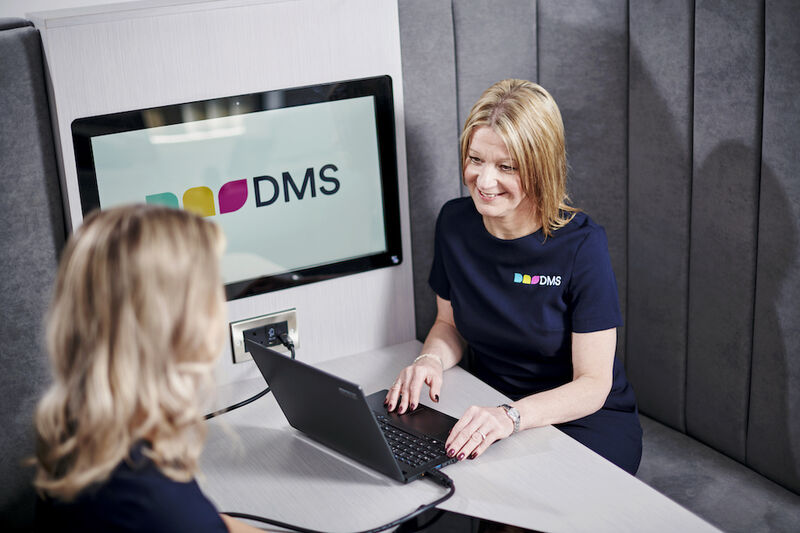Nowadays, many modern businesses operating in offices use a variety of advanced technology in an attempt to better engage their workers and deliver more memorable messaging.
Fortunately, the introduction of interactive touch screens has made it possible to elevate every pitch, presentation or message you wish to convey to your staff.
In this guide, we’ll be explaining exactly how interactive touch screens could benefit your office and how DMS can help to implement an effective audio visual solution for your business.
What are Interactive Touch Screens?
Interactive touch screens, or LFIDs (large-format interactive displays) are essentially giant touch-screen tablets that can be mounted onto a wall or desktop.
They allow users to present more vibrant visual presentations and control on-screen data through digital touchscreen interactions, as opposed to using a screen and projector.
Available in a variety of sizes, interactive LCD panels are suitable for collaborative spaces ranging from small meeting rooms to expansive corporate boardrooms.
They are typically powered by Android, however, users often have the option to integrate Windows as it is usually a more familiar software.
What are the Benefits of Interactive Touch Screens for Offices?
More Memorable Messaging to Staff and Clients
The human brain processes visual content up to 60,000 faster than text and up to 90% of the information transmitted to the brain is visual. This means that visual messaging is one of the best ways to convey information to audiences.
Creating an interactive experience in your office makes what you have to say much more memorable- whether you’re pitching to a client or working collaboratively on a team project, interactive screens will peak and keep the user’s interest.
So, if your goal is to better engage clients and staff and create more memorable messages, interactive screens could be the ideal solution for your office space.
Engaging Meetings
In 2015, a survey found that UK workers will sit through an average of 6,239 meetings throughout their careers. Of the 2,000 survey participants, 70% reported they constantly zone out while in meetings.
That’s why it is absolutely essential to make meetings as interesting and interactive as possible in order to keep your workers engaged.
Due to the way in which large touch screens elevate collaborative working, you can carry out much more fun and interactive brainstorming sessions that keep workers engaged and encourage participation.
More Professional Looking Presentations
Interactive screens enable you to deliver much more professional presentations to your colleagues and clients more easily.
They allow you to use a wide range of multimedia such as content from websites, apps, images, your own files and incredible 4K videos within your presentations, so you can pitch your ideas in a number of different ways.
Improved Efficiency and Reduced Running Costs
Recently, consumers are being more selective with the businesses they buy from, opting for sustainable companies over high-carbon ones. This has meant that many companies are becoming conscious of their impact on the environment, making changes to their operations to reduce emissions wherever possible.
In order to stay ahead of the competition and be more appealing to customers, your business needs to be implementing more environmentally friendly practices and solutions.
Fortunately, modern interactive screens are much more energy efficient than traditional projector screens and printed paper , helping your business to play its part in lowering its emissions and saving the planet.
Not only can you reduce your carbon footprint, you can make significant cost savings as a result of lowering your energy consumption!
Accommodate All Learning Styles
Research has found that people learn best in different ways. Some of us are visual learners, and better understand information that is delivered to us in pictures, videos and diagrams. Others learn better through written and spoken words as well as music, logic and reasoning.
Thankfully, interactive screens allow for multiple learning styles to be met such as reading, watching videos and taking part in physical activities and tasks with access to:
The internet
Apps
Software
4K videos
HD images
Sound
Drawing
Animation Tools and much more.
This makes learning more engaging for all types of learners and helps them to retain information better with a wider range of inclusive learning styles.
Why Choose DMS for Your Interactive Screens?
When it comes to implementing the right kind of technology solutions for your business, you need a team of people that really ‘get’ your business and understand its needs.
Fortunately, at DMS, we have a wealth of experience working with different industries to identify their technology needs.
Our team of experienced account managers are here to help you get the most out of technology, such as the implementation of interactive screens. Our expert team of designers work closely alongside you to create the best possible solution for your budget and workspace.
Following the design stage, our programming and installation team bring the project to life, fitting the interactive screens and putting you in charge of the technology.
For more information on how interactive screens at DMS can help your business flourish, get in touch with one of our friendly team members and book a free demonstration today.









